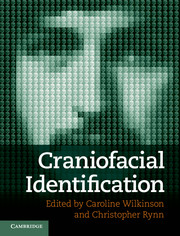Book contents
- Frontmatter
- Contents
- Contributors
- Part I Identification of the Living
- Chapter 1 Familiar face recognition
- Chapter 2 Unfamiliar face recognition
- Chapter 3 EFIT-V
- Chapter 4 Facial recall and computer composites
- Chapter 5 Facial ageing
- Chapter 6 Age progression and regression
- Chapter 7 Computer-assisted age progression
- Chapter 8 Facial recognition from identification parades
- Chapter 9 Virtual human identification line-ups
- Chapter 10 Computer-generated face models
- Chapter 11 Recognising and learning faces in motion
- Chapter 12 Facial image comparison
- Chapter 13 Three-dimensional facial imaging
- Part II Identification of the Dead
- Index
- Plate Section
- References
Chapter 10 - Computer-generated face models
Published online by Cambridge University Press: 05 May 2012
- Frontmatter
- Contents
- Contributors
- Part I Identification of the Living
- Chapter 1 Familiar face recognition
- Chapter 2 Unfamiliar face recognition
- Chapter 3 EFIT-V
- Chapter 4 Facial recall and computer composites
- Chapter 5 Facial ageing
- Chapter 6 Age progression and regression
- Chapter 7 Computer-assisted age progression
- Chapter 8 Facial recognition from identification parades
- Chapter 9 Virtual human identification line-ups
- Chapter 10 Computer-generated face models
- Chapter 11 Recognising and learning faces in motion
- Chapter 12 Facial image comparison
- Chapter 13 Three-dimensional facial imaging
- Part II Identification of the Dead
- Index
- Plate Section
- References
Summary
Introduction
The rapid progress in digital image capture and computer processing power has provided new opportunities for the analysis and synthesis of facial shape and appearance. New algorithms have been developed to exploit these improvements and have found applications in health, security and forensics. In this chapter some of the main techniques that have been developed to capture, model and process facial image data are reviewed.
Data capture
Photography
The simplest technique for capturing facial image data is photography. There have been rapid improvements in the resolution of digital cameras, so that the quality of direct digital capture equals or even exceeds chemical film. While two-dimensional (2D) images present the simplest method for facial image capture, 2D data present a number of problems when it comes to analysing and processing the data. Faces are inherently 3D in nature and the projection to 2D can introduce variation in the appearance that is not intrinsic to the faces themselves. Even small changes in the facial orientation can produce a vastly different projected 2D facial shape. Changes in lighting are also difficult to model and remove using purely 2D methods.
- Type
- Chapter
- Information
- Craniofacial Identification , pp. 115 - 124Publisher: Cambridge University PressPrint publication year: 2012
References
- 2
- Cited by



